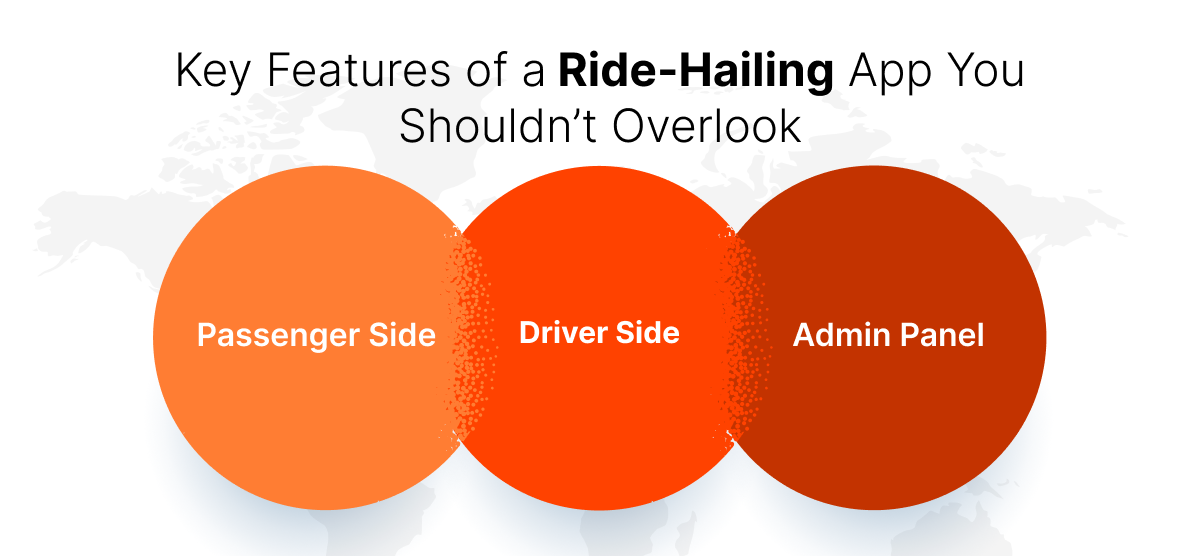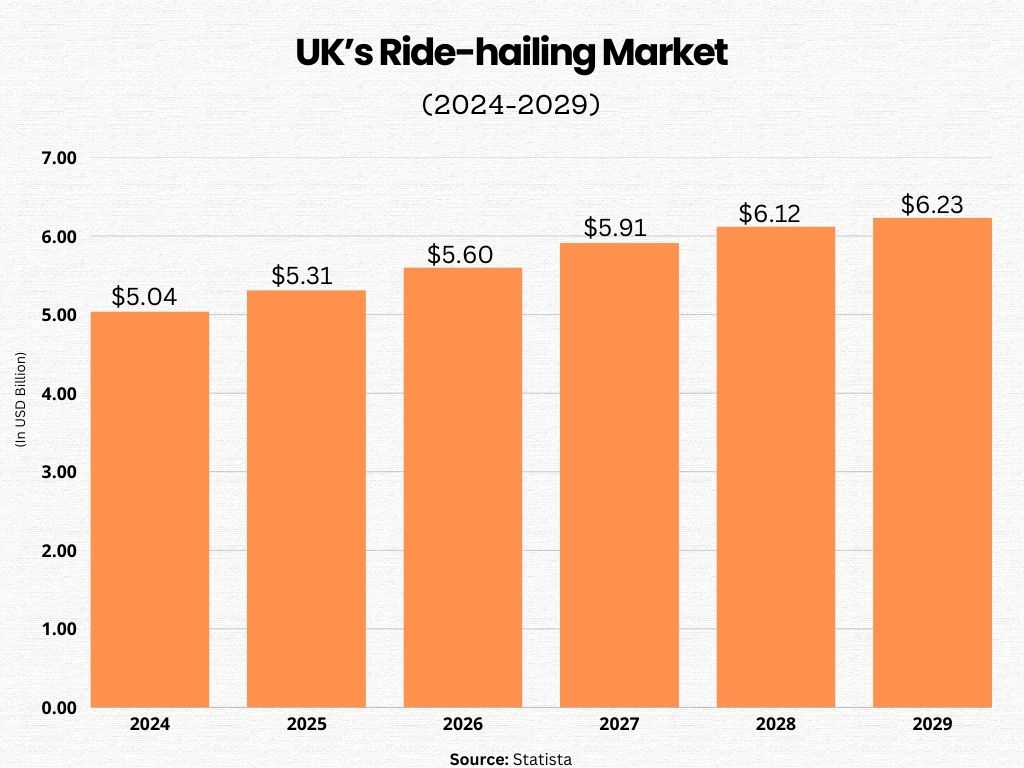How to Build a Ride-Hailing App Like Bolt Taxi in the UK?

Back in 2019, when Bolt first entered the UK ride-hailing market, who would have expected it to grow rapidly and become one of the largest taxi apps today? Now, it stands as a direct competitor to Uber, challenging the industry giant with its growing presence and popularity. What’s more surprising is that these two taxi app giants together dominate around 90% of the UK ride-sharing market, meaning there’s still room for new entrants to innovate and take advantage of underlying opportunities.
As we all know, the UK’s ride-hailing industry is vast, and addressing users’ every issue isn’t possible for these companies, but there's a competitive edge to be gained. As a competitor planning to build an app like Bolt Taxi, you can differentiate yourself by offering features and solutions to the problems these companies might have overlooked. And who knows, your app could be the next big thing in the industry.
So, if you’re impressed with Bolt’s business models and want to build an app like that or have a distinct app idea that you think will be a hit in the UK’s taxi booking app, you will first need to understand the basics of taxi app development through this comprehensive guide. We will understand the business model of Bolt, app development process, required tech stack, and cost.
Understanding Bolt’s Business Model
The UK’s ride-hailing market is vast and worth around $5.04 billion. It is expected that the market will grow to $6.23 billion by the end of 2029, at a CAGR of 5.45%, according to Statista.
Bolt Taxi app, formerly known as Taxify, was launched in 2013 and managed to create a user base of 10 million by 2018. However, it's rebranding from Taxify to Bolt benefitted the business, with over 25 million global users by 2019 and more than 150 million by 2024. The company debuted in the UK ride-hailing market in 2019 and has 9 million active users in the region.
Bolt’s business model is simple: it takes a commission from every ride completed on its platform. This commission is usually around 15-20% of the fare, while the rest goes to the driver. Bolt also offers other services like e-scooters and food delivery, but ride-hailing is its main business.
In the UK, Bolt operates in major cities like London, Birmingham, Manchester, and Leeds. It competes with other ride-hailing giants like Uber, which dominates the market. As of 2025, Uber holds around 70-75% of the UK ride-hailing market, while Bolt has a smaller share, estimated at 5-10%. Despite being smaller, Bolt is growing fast because it offers lower prices and better earnings for drivers.
Bolt makes money by charging a commission on rides. For example, if a ride costs £10, Bolt might take £2, and the driver gets £8. The company focuses on keeping costs low to attract both riders and drivers.
Key Features of a Ride-Hailing App You Shouldn’t Overlook
While developing a taxi booking app, it is crucial to integrate all essential features and functionalities. The features of the app are what make it big in the industry. The more appealing and user-friendly the features are, the higher the chances of users returning and sticking with the app.
#1. Passenger Side
Here are some essential features every taxi booking app must include to ensure a seamless and hassle-free experience for riders:
- App Registration: Users should be able to sign up quickly by entering basic details like their name, phone number, and email address. For added convenience, the app should also allow registration through social media accounts like Gmail or Facebook.
- Ride Booking: The app should offer two options: booking a ride instantly or scheduling it for later. This flexibility makes it easier for riders to plan their trips according to their needs.
- Payment Options: Secure payment gateways should be integrated into the app, allowing passengers to pay directly through it. Include multiple payment methods like credit/debit cards, digital wallets, and net banking for a smooth and convenient payment experience.
- App Notifications: Riders should receive real-time notifications when a driver accepts or cancels their ride request. These notifications should include details like the driver’s name, vehicle model, license plate number, and estimated arrival time.
- Fare Calculator: The app should display an estimated fare for the trip along with a detailed fare breakdown before the rider confirms the booking. This helps users know the cost upfront and avoid surprises.
- Trip History: A trip history section should store all the details of the rider’s past trips, including routes, fares, and payment information. This feature helps users keep track of their travel history and expenses.
- Driver/Trip Rating: Riders should be able to rate their driver and leave reviews after each trip. This feature not only helps other users make informed decisions but also builds trust and improves the overall quality of service.
#2. Driver Side
The driver side of the app shares some similarities with the passenger side, but it focuses more on navigation, payments, and managing ride requests. Here are the key features every driver app should include:
- Registration: Drivers need to sign up by providing personal details and uploading necessary documents like their driver’s license, address proof, and national ID for verification.
- Notifications: The app should send real-time notifications to drivers, such as ride requests, rider details, and updates on ride acceptance or rejection. It should also allow drivers to contact riders directly if needed.
- Trip Alerts: Drivers should receive alerts for new ride requests, including details like pickup location, payment status, and navigation instructions. The app should let drivers accept or decline trips and provide a reason for cancellation to avoid misunderstandings with riders.
- Navigation/Location: In-app navigation helps drivers find the best routes and navigate unfamiliar areas. Including offline maps can ensure drivers continue their trips even in areas with poor internet connectivity.
- Trip Reports: The app should generate trip reports that show drivers their ride statistics, including the number of trips completed, earnings, and any pending payments. This helps drivers track their performance and income.
#3. Admin Panel
The admin panel is the central area of the taxi booking app and is designed to store and manage all the data related to passengers, drivers, and trips. It also keeps track of all financial transactions, ensuring that everything runs smoothly.

- Database Management: The admin panel stores detailed information about passengers and drivers, including their profiles, trip history, and payment records.
- Trip Monitoring: Admins can view ongoing trips, track their progress, and resolve any issues that arise during the ride.
- Financial Tracking: The panel records all transactions, helping admins manage payments, earnings, and settlements between passengers and drivers.
- Advanced Features: To boost the app’s performance, the admin panel can be integrated with tools like Google Analytics. This allows admins to analyze user behavior, track app usage, and gather insights to improve the app’s functionality.
Required Tech Stack for Building Bolt Like App
Before you invest in taxi app development, it is crucial to understand how you can make it advanced and adaptable to users’ dynamic demands. It’s all about the technology that fuels the success of ride-sharing apps like Bolt.
Here’s a table highlighting the necessary tech stack for building Bolt:
Component | Technology |
Frontend | React, Vue, Angular, HTML, CSS, JavaScript, TypeScript |
Backend | Node.js, Express.js, Django, Flask, Ruby on Rails |
Database | PostgreSQL, MySQL, MongoDB, Firebase |
Authentication | OAuth, JWT, Firebase Authentication |
Hosting | AWS, Google Cloud, Heroku, Vercel |
APIs | RESTful APIs, GraphQL |
DevOps | Docker, Kubernetes, Jenkins, GitHub Actions |
Real-time | WebSockets, Socket.io, Firebase Realtime Database |
AI Integration | OpenAI, TensorFlow, PyTorch |
Version Control | Git, GitHub, GitLab |
Testing | Jest, Mocha, Chai, Cypress |
CI/CD | CircleCI, Travis CI, GitHub Actions |
Steps to Build a Taxi App Like Bolt
Taxi app development is a lengthy process and undergoes a few crucial steps. You can’t risk skipping even a single step in the process. Here are the essential stages of a ride-hailing app development lifecycle.
Step 1. Conduct Thorough Market Research
Start by diving deep into market research to understand customer needs, pain points, and current industry trends. Study existing ride-hailing apps to learn what users like and dislike about them.
Focus on analyzing your competitors—look at their strengths, weaknesses, pricing strategies, service quality, and any unique features they offer. This will help you identify gaps in the market and opportunities to stand out.
By gathering these insights, you can strategically position your app, define a strong unique selling proposition (USP), and create features that make your app better than the rest. This step is crucial for building an app that truly meets user expectations and stands out in a competitive market.
Step 2. Define Your Unique Selling Proposition
To succeed in the competitive ride-hailing industry, your app needs a unique selling proposition (USP) that makes it stand out. This will help attract both drivers and riders. Here are some ideas to make your app different:
- Lower Commission Rates for Drivers: Offering drivers a higher share of earnings can encourage more drivers to join your platform, increasing the availability of vehicles.
- Advanced Safety Features: Include features like an SOS button, real-time ride tracking, or background-verified drivers to build trust and ensure user safety.
- Specialized Ride Options: Cater to specific needs by offering niche services like luxury rides, eco-friendly electric taxis, or options tailored for families or business travelers.
Step 3. Define Monetization Strategy
A clear and effective monetization strategy is essential to keep your ride-hailing app running and profitable. Decide how your app will make money by exploring these revenue models:
- Commission-Based Model: Take a small percentage from every ride booked through your app.
- Subscription Services: Offer premium features for users or discounted commission rates for drivers in exchange for a monthly or yearly fee.
- In-App Ads and Partnerships: Earn revenue by displaying targeted ads or partnering with local businesses.
- Surge Pricing: Increase fares during busy times to maximize earnings when demand is high.
- Cancellation/Wait Time Fees: Charge riders for late cancellations or if they keep drivers waiting too long, compensating for lost time.
- Loyalty Programs: Reward frequent users with discounts or perks to encourage them to keep using your app.
Step 4. Choose the Platform (Android and iOS)
Android and iOS have different user bases, so launching a taxi app on both platforms is crucial to reach the widest audience. By making your app available on both platforms, you can attract more customers and drivers, expanding your user base significantly.
To ensure success, your app should work smoothly on both operating systems, providing a consistent experience for all users. Developing native apps for each platform is the best approach, as it ensures faster performance, better security, and improved responsiveness.
While it may require more effort, focusing on both Android and iOS is a smart move if you want to maximize profits and deliver a high-quality app.

Step 5. Implement Flawless UX/UI Design
Users enjoy apps that are visually appealing and easy to use. To create a strong connection with your audience, start by designing wireframes, prototypes, and mockups that mimic the look and functionality of the final app.
These early versions allow you to test and refine the app’s design before launching the official version. A smooth and intuitive interface will keep users engaged and satisfied.
Step 6. Focus on Backend Development
A taxi booking app handles massive amounts of data and real-time processing, making backend development critical. The back-end acts as the app’s backbone, connecting data sources, payment systems, and communication tools. It must efficiently manage and distribute data while ensuring seamless interaction between the driver and passenger interfaces.
However, processing this data can be challenging due to its high volume, diverse sources, and constant real-time updates. A well-built backend ensures the app runs smoothly and reliably.
Step 7. Mobile App Testing & Launch
Before releasing your taxi booking app, conduct thorough testing to ensure it’s free of errors and provides a smooth user experience. Once testing is complete, launch the app on major platforms like the Apple App Store and Google Play Store.
While this step involves additional costs, it’s a worthwhile investment for long-term business growth and success.
Step 8. Mobile App Support & Maintenance
After launching your app, ongoing support and maintenance are essential to keep it running smoothly. Regularly update the app to align with market trends, fix bugs, and improve performance.
Although this isn’t part of the initial development process, it’s crucial for ensuring the app remains functional, relevant, and user-friendly for years to come. Investing in support and maintenance will help sustain your app’s success over time.
How Much Does It Cost to Develop An App Like Bolt?
Creating an app like Bolt can be expensive, and the final cost depends on various factors. These include the features you want, the complexity of the app, the platforms it will launch on, the technology used, and more. A simple ride-hailing app with basic features might cost between £10,000 and £30,000 or more.
However, if you want a more advanced app like Bolt with features such as real-time tracking, multiple payment options, separate apps for drivers and passengers, and the ability to operate in multiple locations, the cost could rise to several hundred thousand dollars. This depends on the services provided by the mobile app development company.
Additionally, you need to account for other expenses like app maintenance, server hosting, marketing, and ensuring compliance with legal regulations. The total cost can also vary based on whether you build an in-house team or outsource the work, as well as the type of technology and tools you choose to use.
Conclusion
Building an app like Bolt is an exciting yet challenging journey. It requires thorough market research, strategic planning, legal compliance, assembling a skilled development team, choosing the right technology, and designing a user-friendly app. The ride-hailing industry is highly competitive, so having a unique idea and a strong focus on quality is crucial.
It’s important to understand the costs and potential challenges from the beginning. Stay flexible to adapt to market trends and technological advancements. With dedication, the right resources, and a customer-centric approach, creating an app like Bolt can be a rewarding and profitable venture in the fast-evolving transportation and tech landscape. If you’re ready to take the first step, follow these key steps to build a solid foundation for your app’s success.
Partner with Mtoag Technologies, a top on-demand app development company, to turn your business idea into reality. Our team of expert taxi booking app developers specializes in creating attractive, functional apps at affordable costs. Let us help you bring your ride-hailing app idea to life!
FAQs
Is Bolt Taxi Cheaper Than Uber?
Bolt is often cheaper than Uber due to its competitive pricing strategy and lower commission rates for drivers. However, prices can vary depending on demand, time of day, and location. Both platforms use dynamic pricing, so it’s best to compare fares in real-time for the most accurate cost comparison.
Is There Bolt Taxi in the UK?
Yes, Bolt operates in several UK cities, including London, Birmingham, and Manchester. It offers ride-hailing services similar to Uber, providing an alternative for passengers and drivers. Availability may vary by city, so check the app to see if it’s accessible in your area.
Is Bolt Legal in the UK?
Yes, Bolt is legal in the UK. The company complies with local regulations, including licensing requirements for drivers and vehicles. It operates under the same legal framework as other ride-hailing services, ensuring passenger safety and fair business practices.
How Much Do Bolt Drivers Get Paid in the UK?
Bolt drivers in the UK typically earn between £10-£15 per hour after expenses, depending on demand, location, and hours worked. Bolt takes a lower commission (around 15%) compared to competitors, allowing drivers to retain more earnings. However, income can vary based on fuel costs, vehicle maintenance, and other factors.
Is Bolt Available 24 Hours?
Yes, Bolt operates 24 hours in most UK cities where it’s available. However, driver availability may vary during late-night or early-morning hours. Passengers can check the app to see real-time driver availability and estimated wait times.
Is Bolt a Safe App?
Bolt is considered a safe app, with features like driver verification, ride tracking, and an emergency button for added security. Both drivers and passengers are rated after each trip, promoting accountability. However, as with any ride-hailing service, users should remain vigilant and share trip details with trusted contacts.

Yogesh Pant
Yogesh Pant is a CEO and founder of Mtoag Technologies, a Top mobile app development company specialized in android and iOS app development.
Subscribe Us
Join fellow entrepreneurs! Get Mtoag' latest articles straight to your inbox.



